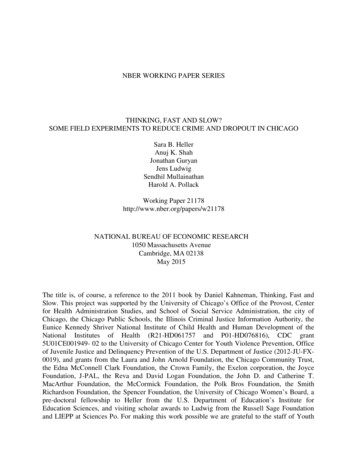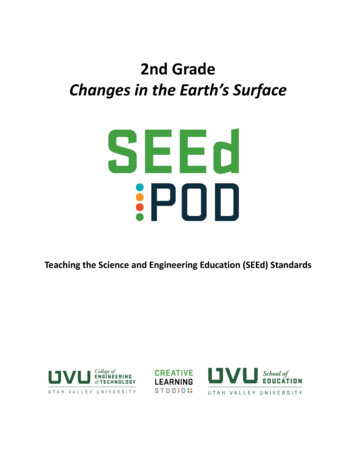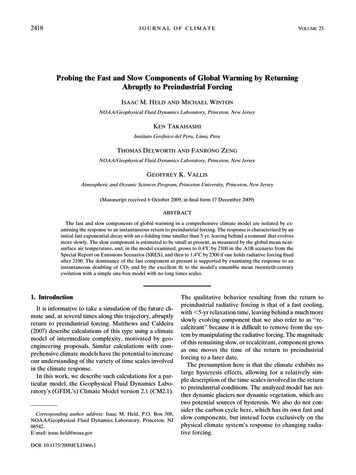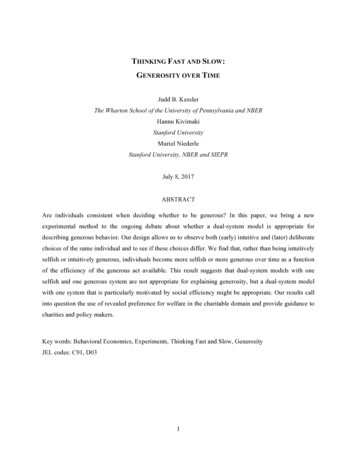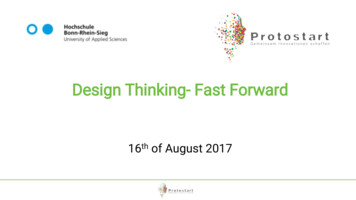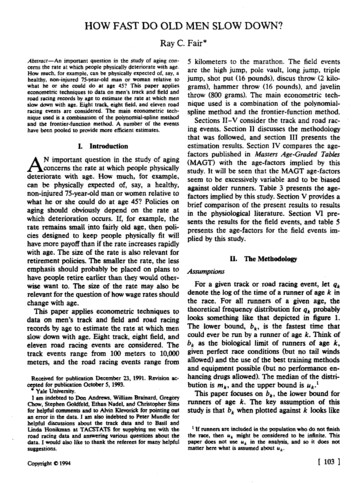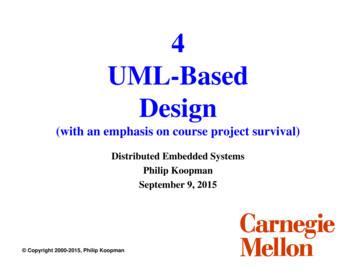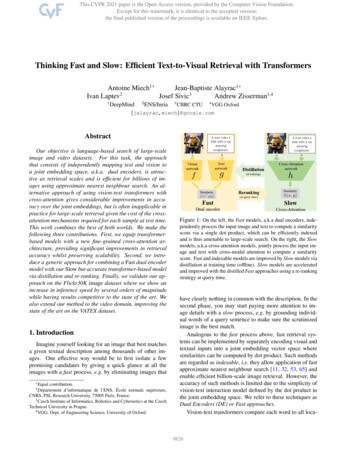
Transcription
Thinking Fast and Slow: Efficient Text-to-Visual Retrieval with TransformersAntoine Miech1 *Jean-Baptiste Alayrac1 *Ivan Laptev2Josef Sivic3Andrew Zisserman1,41DeepMind2ENS/Inria3CIIRC CTU4VGG Oxford{jalayrac,miech}@google.comAbstractOur objective is language-based search of large-scaleimage and video datasets. For this task, the approachthat consists of independently mapping text and vision toa joint embedding space, a.k.a. dual encoders, is attractive as retrieval scales and is efficient for billions of images using approximate nearest neighbour search. An alternative approach of using vision-text transformers withcross-attention gives considerable improvements in accuracy over the joint embeddings, but is often inapplicable inpractice for large-scale retrieval given the cost of the crossattention mechanisms required for each sample at test time.This work combines the best of both worlds. We make thefollowing three contributions. First, we equip transformerbased models with a new fine-grained cross-attention architecture, providing significant improvements in retrievalaccuracy whilst preserving scalability. Second, we introduce a generic approach for combining a Fast dual encodermodel with our Slow but accurate transformer-based modelvia distillation and re-ranking. Finally, we validate our approach on the Flickr30K image dataset where we show anincrease in inference speed by several orders of magnitudewhile having results competitive to the state of the art. Wealso extend our method to the video domain, improving thestate of the art on the VATEX dataset.1. IntroductionImagine yourself looking for an image that best matchesa given textual description among thousands of other images. One effective way would be to first isolate a fewpromising candidates by giving a quick glance at all theimages with a fast process, e.g. by eliminating images that* Equal contribution.1 Département d’informatiquede l’ENS, École normale supérieure,CNRS, PSL Research University, 75005 Paris, France.3 Czech Institute of Informatics, Robotics and Cybernetics at the CzechTechnical University in Prague.4 VGG, Dept. of Engineering Science, University of OxfordA man rides abike with a catwearingsunglasses.TextnetworkVisionnetworkA man rides abike with a twork(at training)SimilarityRerankingSimilarity(at query time)FastSlowDual encoderCross-AttentionFigure 1: On the left, the Fast models, a.k.a dual encoders, independently process the input image and text to compute a similarityscore via a single dot product, which can be efficiently indexedand is thus amenable to large-scale search. On the right, the Slowmodels, a.k.a cross-attention models, jointly process the input image and text with cross-modal attention to compute a similarityscore. Fast and indexable models are improved by Slow models viadistillation at training time (offline). Slow models are acceleratedand improved with the distilled Fast approaches using a re-rankingstrategy at query time.have clearly nothing in common with the description. In thesecond phase, you may start paying more attention to image details with a slow process, e.g. by grounding individual words of a query sentence to make sure the scrutinizedimage is the best match.Analogous to the fast process above, fast retrieval systems can be implemented by separately encoding visual andtextual inputs into a joint embedding vector space wheresimilarities can be computed by dot product. Such methodsare regarded as indexable, i.e. they allow application of fastapproximate nearest neighbour search [11, 32, 53, 65] andenable efficient billion-scale image retrieval. However, theaccuracy of such methods is limited due to the simplicity ofvision-text interaction model defined by the dot product inthe joint embedding space. We refer to these techniques asDual Encoders (DE) or Fast approaches.Vision-text transformers compare each word to all loca-9826
tions in the image using cross-attention [12, 29, 46], allowing for grounding, and can be related to the slow processmentioned earlier. Such methods, referred to here as Crossattention (CA) or Slow approaches, significantly boost retrieval performance. Modeling text-vision interactions withattention, however, makes these models slow and impractical for large-scale image retrieval given the cost of thecross-attention mechanisms required for each sample at testtime. Hence, the challenge we consider is the following:How to benefit from accurate cross-attention mechanismswhile preserving the fast and scalable visual search?Our short answer is: By thinking Fast and Slow [10].As illustrated in Figure 1, we propose to combine dual encoder approaches with cross-attention via two complementary mechanisms. First, we improve Fast DE models witha novel distillation objective that transfers knowledge fromaccurate but Slow CA models to the Fast and indexable dualencoders. Second, we propose to combine DE and CA models with re-ranking where a few most promising candidatesobtained with the Fast model are re-ranked using the Slowmodel. Our resulting approach is both fast and accurate.Since the speed of CA is not a bottleneck anymore, wefurther improve performance by enriching the vision-textcross-attention model with a novel feature map upsamplingmechanism enabling fine-grained attention. Note that ourwork can also be applied to vision-to-text retrieval. However, we focus on text-to-vision retrieval due to its widerpractical application.Contributions. (i) We first propose a gradual feature upsampling architecture for improved and fine-grained visionand text cross-attention. Our model is trained with a bidirectional captioning loss which is remarkably competitive for retrieval compared to standard cross-modal matching objectives. (ii) We introduce a generic approach forscaling-up transformer-based vision-text retrieval using twocore ideas: a method to distill the knowledge of Slow crossattention models into Fast dual-encoders, and re-rankingtop results of the Fast models with the Slow ones. (iii) Finally, we validate our approach on image retrieval with theCOCO [43] and Flickr30K [60] datasets and show we canreduce the inference time of powerful transformer-basedmodels by 100 whilst also getting competitive results tothe state of the art. We also successfully extend our approach to text-to-video retrieval and improve state of the arton the challenging VATEX [73] dataset.2. Related workVision and Language models. Driven by the significantadvances in language understanding lead by Transformers [13, 70], recent works have explored the use of thesearchitectures for vision and language tasks. Many of themin image [8, 37, 39, 40, 46, 67, 68, 78] or video [79]rely on pretrained object detectors used for extracting ROIsthat are viewed as individual visual words. A few otherworks, such as PixelBERT [29] and VirTex [12] for images or HERO [38] for video, operate directly over densefeature maps instead of relying on object detectors. Inthese approaches, both vision and text inputs are fed into aTransformer-based model usually pretrained with multiplelosses such as a cross-modal matching loss, a masked language modelling or a masked region modelling loss. Othernon-Transformer based vision and text approaches used recurrent neural networks [14, 15, 36], MLP [71, 72], or bagof-words [19, 51] text models. These models are then usually optimized with objectives such as CCA [19], max margin triplet loss [15, 71, 72, 74, 75], contrastive loss [23]and, more related to our work, by maximizing text loglikelihoods conditioned on the image [14]. In our work,we focus on the powerful vision-text Transformer modelsfor retrieval and particularly address their scalability, whichwas frequently neglected by prior work.Language-based visual search. A large number of vision and language retrieval models [15, 19, 20, 36, 50, 51,55, 59, 71, 72, 74, 75, 77] use a dual encoder architecturewhere the text and vision inputs are separately embeddedinto a joint space. These approaches can efficiently benefit from numerous approximate nearest neighbour searchmethods such as: product quantization [32], inverted indexes [65], hierarchical clustering [53] or locality sensitivehashing [11], for fast and scalable visual search. In contrast,state-of-the-art retrieval models rely on large vision-textmultimodal transformers [8, 29, 37, 39, 46, 47, 67, 68, 78].In these approaches, both vision and text inputs are fed intoa cross-modal attention branch to compute the similarity between the two inputs. This scoring mechanism based oncross-modal attention makes it particularly inadequate forindexing and thus challenging to deploy at a large scale.Our work aims at addressing this issue by connecting scalable visual search techniques with these powerful yet nonindexable vision-text cross-attention based models.Re-ranking. Re-ranking retrieval results is standard in retrieval systems. In computer vision, the idea of geometricverification [31, 57] is used in object retrieval to re-rank objects that better match the query given spatial consistencycriteria. Query expansion [9] is another re-ranking technique where the query is reformulated given top retrievedcandidates, and recent work has brought attention mechanisms into deep learning methods for query expansion [21].Related to language-based visual search, re-ranking by avideo-language temporal alignment model has been used toimprove efficient moment retrieval in video [16]. In contrast, we focus on transformer-based cross-attention modelsand develop a distillation objective for efficient retrieval.Distillation. Knowledge distillation [3, 28] has proven tobe effective for improving performance in various computer vision domains such as weakly-supervised learn-9827
ing [41, 61], depth estimation [22], action recognition [66],semantic segmentation [44], self-supervised learning [58]or self-training [76]. One major application of distillation isin compressing large and computationally expensive models in language analysis [63], object detection [5], imageclassification or speech recognition [28] into smaller andcomputationally less demanding models. In this work, wedescribe a distillation mechanism for the compression ofpowerful but non-indexable vision-text models into indexable models suitable for efficient retrieval.3. Thinking Fast and Slow for RetrievalThis section describes our proposed approach to learnboth fast and accurate model for language-based image retrieval. Our goal is to train the model to output a similarityscore between an input image x and a textual description y.In this work, we focus on two families of models: the Fastand the Slow models, as illustrated in Figure 1.The Fast model, referred to as the dual encoder approach, consists of extracting modality-specific embeddings: f (x) Rd for the image and g(y) Rd for thetext. The core property of this approach is that the similarity between an image x and a text y can be computedvia a single dot product f (x) g(y). Hence, these methodscan benefit from approximate nearest neighbour search forefficient large-scale retrieval [32, 53, 65].The Slow model, referred to as the cross-attention approach differs by a more complex modality merging strategy based on cross-modal attention. We assume the givensimilarity score h(x, y) cannot be decomposed as a dotproduct and as such is not indexable. These models allow for richer interactions between the visual and textualrepresentations, which leads to better scoring mechanisms,though at a higher computational cost.Section 3.1 introduces the (Slow) cross-attention modelconsidered in this work and details our contribution on themodel architecture that leads to a more accurate text-toimage retrieval system. Section 3.2 describes how we obtainboth a fast and accurate retrieval method by combining theadvantages of the two families of models.3.1. Thinking Slow with cross-attentionGiven an image x and a text description y, a Slow crossattention retrieval model h computes a similarity score between the image and text as:h(x, y) A(φ(x), y),(1)where φ is a visual encoder (e.g. a CNN). A is a networkthat computes a similarity score between φ(x) and y usingcross-attention [46, 70] mechanisms, i.e. the text attends tothe image or vice versa via multiple non-linear functions involving both the visual and language representations. Suchmodels emulate a slow process of attention which results inbetter text-to-image retrieval.We propose two important innovations to improve suchmodels. First, we introduce a novel architecture that enables fine-grained visual-text cross-attention by efficientlyincreasing the resolution of the attended high-level imagefeatures. Second, we propose to revisit the use of a captioning loss [14] to train retrieval models and discuss thebenefits over standard alternatives that use classification orranking loss [8, 37, 39, 46, 67, 68, 78].A novel architecture for fine-grained vision-textcross-attention. A typical approach to attend to visual features produced by a CNN is to consider the last convolutional layer [12, 29]. The feature map is flattened into a setof feature vectors that are used as input to vision-languagecross-attention modules. For example, a 224 224 inputimage passed through a ResNet-50 [26] outputs a 7 7 feature map that is flattened into 49 vectors. While the last feature map produces high-level semantic information crucialfor grounding text description into images, this last featuremap is also severely downsampled. As a result, useful finegrained visual information for grounding text descriptionsmight be lost in this downsampling process.One solution to the problem is to increase the input image resolution. However, this significantly raises the cost ofrunning the visual backbone. Inspired by previous work insegmentation [2, 25, 62] and human pose estimation [54],we instead propose to gradually upsample the last convolutional feature map conditioned on earlier higher resolution feature maps, as illustrated in Figure 2. We choosea lightweight architecture for this upsampling process inspired by recent advances in efficient object detection [69].In Section 4, we show large improvements of this approachover several baselines and also show its complementarityto having higher resolution input images, clearly demonstrating the benefits of the proposed fine-grained visionlanguage cross-attention.Bi-directional captioning objective for retrieval. A majority of text-vision transformer-based retrieval models [8,37, 39, 46, 67, 68, 78] rely on a cross-modal imagetext matching loss to discriminate positive image-text pairs(x, y) from negative ones. In this work, we instead explorethe use of a captioning model for retrieval. Given an inputtext query y, retrieval can be done by searching the imagecollection for the image x that leads to the highest likelihood of y given x according to the model. In detail, we takeinspiration from VirTex [12] and design the cross-attentionmodule A as a stack of Transformer decoders [70] takingthe visual feature map φ(x) as an encoding state. Each layerof the decoder is composed of a masked text self-attentionlayer, followed by a cross-attention layer that enables thetext to attend to the visual features and finally a feed forward9828
SimilarityConvconv2Convconv3 l(dog)Convconv4conv57 x 7 x 204814 x 14 x 1024224 x 224 x 37 x 7 x 512ResNet[bos]14 x 14 x 512Gradual upsamplingadog outsideA dog rides a bike outside.28 x 28 x 51228 x 28 x 51256 x 56 x 256TransformerDecoder2xUP2xUP2xUP56 x 56 x 51256 x 56 x 512QueryFigure 2: Our Slow retrieval model computes a similarity score h(x, y) between image x and query text description y by estimating thelog-likelihood of y conditioned on x. In other words, given an input text query y, we perform retrieval by searching for an image x thatis the most likely to decode caption y. l(.) denotes the log probability of a word given preceding words and the image. The decoder is aTransformer that takes as the conditioning signal a high-resolution (here 56 56) feature map φ(x). In this example, φ(x) is obtained bygradually upsampling the last convolutional layer of ResNet (7 7) while incorporating features from earlier high-resolution feature maps.The decoder performs bidirectional captioning but, for the sake of simplicity, we only illustrate here the forward decoding transformer.layer. One advantage of this architecture compared to standard multimodal transformers [8, 37, 39, 46, 67, 68, 78] isthe absence of self-attention layers on visual features, whichallows the resolution of the visual feature map φ(x) to bescaled to thousands of vectors. We write the input text asy [y 1 , . . . , y L ] where L is the number of words. Formally, the model h scores a pair of image and text (x, y)as:h(x, y) hf wd (x, y) hbwd (x, y),(2)where hf wd (x, y) (resp. hbwd (x, y)) is the forward (resp.backward) log-likelihood of the caption y given the imagex according to the model:hf wd (x, y) LXcross entropy loss is taken (see Eq. (3)) which effectivelymeans that all other tokens in the vocabulary are consideredas negatives.In this section, we have described the architectureand the chosen loss for training our accurate Slow crossattention model for retrieval. One key remaining challengeis in the scaling of h(x, y) using Eq. (1) to large imagedatasets as: (i) the network A is expensive to run and (ii) theresulting intermediate encoded image, φ(x), is too large tofit the entire encoded dataset in memory. Next, we introduce a generic method, effective beyond the scope of ourproposed Slow model, for efficiently running such crossmodal attention-based models at a large scale.log(p(y l y l 1 , . . . , y 1 , φ(x); θf wd )),l 1(3)where p(y l y l 1 , . . . , y 1 , φ(x); θ) corresponds to the output probability of a decoder model parametrized by θ forthe token y l at position l given the previously fed tokensy l 1 , . . . , y 1 and the encoded image φ(x). θf wd is the parameters of the forward transformer models. hbwd (x, y) isthe same but with the sequence y 1 , . . . , y L in reverse order.The parameters of the visual backbone, the forward andbackward transformermodels are obtained by minimizingPnLCA i 1 h(xi , yi ) where n is the number of annotated pairs of images and text descriptions {(xi , yi )}i [1,n] .We show in Section 4 that models trained for captioningcan perform on-par with models trained with the usual contrastive image-text matching loss. At first sight this may appear surprising as the image-text matching loss seems moresuited for retrieval, notably because it explicitly integratesnegative examples. However, when looked at more closely,the captioning loss actually shares similarities with a contrastive loss: for each ground truth token of the sequence a3.2. Thinking Faster and better for retrievalIn this section, we introduce an approach to scale-up theSlow transformer-based cross-attention model, described inthe previous section, using two complementary ideas. First,we distill the knowledge of the Slow cross-attention modelinto a Fast dual-encoder model that can be efficiently indexed. Second, we combine the Fast dual-encoder modelwith the Slow cross-attention model via a re-ranking mechanism. The outcome is more than 100 speed-up and, interestingly, an improved retrieval accuracy of the combinedFast and Slow model. Next, we give details of the Fastdual encoder model, then explain the distillation of the Slowmodel into the Fast model using a teacher-student approach,and finally describe the re-ranking mechanism to combinethe outputs of the two models. Because our approach ismodel agnostic, the Slow model can refer to any vision-texttransformer and the Fast to any dual-encoder model. Anoverview of the approach is illustrated in Figure 1.9829
Fast indexable dual encoder models. We consider Fastdual encoder models, that extract modality specific embeddings: f (x) Rd from image x, and g(y) Rd from texty. The core property of this approach is that the similarity between the embedded image x and text y is measuredwith a dot product, f (x) g(y). The objective is to learnembeddings f (x) and g(y) so that semantically related images and text have high similarity and the similarity of unrelated images and text is low. To achieve that we train theseembeddings by minimizing the standard noise contrastiveestimation (NCE) [24, 33] objective:from Eq. (5) by f (x) g(y):q(Bi )(x, y) Pexp(f (x) g(y)/τ ).′ ′(x′ ,y ′ ) Bi exp(f (x ) g(y )/τ )(6)Given the above definition of the sampled distributions,we use the following distillation loss that measures the similarity between the teacher distribution p(Bi ) and the studentdistribution q(Bi ) as :Ldistill nXH(p(Bi ), q(Bi )),(7)i 1LDE nXi 1 log f (xi ) g(yi )ef (xi) g(yei) Pef (x′ ) g(y ′ )(x′ ,y ′ ) Ni ,(4)which contrasts the score of the positive pair (xi , yi ) to aset of negative pairs sampled from a negative set Ni . In ourcase, the image encoder f is a globally pooled output of aCNN while the text encoder g is either a bag-of-words [51]representation or a more sophisticated BERT [13] encoder.Implementation details are provided in Section 4.1.Distilling the Slow model into the Fast model. Given thesuperiority of cross-attention models over dual encoders forretrieval, we investigate how to distill [28] the knowledgeof the cross-attention model to a dual encoder. To achievethat we introduce a novel loss. In detail, the key challenge isthat, as opposed to standard distillation used for classification models, here we do not have a small finite set of classesbut potentially an infinite set of possible sequences of wordsdescribing an image. Therefore, we cannot directly applythe standard formulation of distillation proposed in [28].To address this issue, we introduce the following extension of distillation for our image-text setup. Given animage-text pair (xi , yi ), we sample a finite subset of imagetext pairs Bi {(xi , yi )} {(x, yi ) x 6 xi }, wherewe construct additional image-text pairs with the same textquery yi but different images x. Note that this is similar tothe setup that would be used to perform retrieval of imagesx given a text query yi . In practice, we sample differentimages x within the same training batch. We can write aprobability distribution measuring the likelihood of the pair(x, y) Bi according to the Slow teacher model h(x, y)(given by eq. (1)) over subset Bi as:p(Bi )(x, y) Pexp(h(x, y)/τ ),exp(h(x′ , y ′ )/τ )i(5)where H is the cross entropy between the two distributions.The intuition is that the teacher model provides soft targets over the sampled image-text pairs as opposed to binarytargets in the case of a single positive pair and the rest ofthe pairs being negative. Similarly to the standard distillation [28], we combine the distillation loss (7) with the DEloss (4) weighted with α 0 to get our final objective as:min Ldistill αLDE .f,g(8)Re-ranking the Fast results with the Slow model. Thedistillation alone is usually not sufficient to recover the fullaccuracy of the Slow model using the Fast model. To address this issue, we use the Slow model at inference time tore-rank a few of the top retrieved candidates obtained using the Fast model. First, the entire dataset is ranked bythe (Distilled) Fast model that can be done efficiently using approximate nearest neighbour search, which often hasonly sub-linear complexity in the dataset size. Then the topK (e.g. 10 or 50) results are re-ranked by the Slow model.As the Slow model is applied only to the top K results itsapplication does not depend on the size of the database.More precisely, given an input text query y and an imagedatabase X containing a large number of m images, we firstobtain a subset of K images XK (where K m) that havethe highest score according to the Fast dual encoder model.We then retrieve the final top ranked image by re-rankingthe candidates using the Slow model:arg max h(x, y) βf (x) g(y),(9)x XKwhere β is a positive hyper-parameter that weights the output scores of the two models. In the experimental Section 4, we show that combined with distillation, re-rankingless than ten examples out of thousands can be sufficient torecover the performance of the Slow model.(x′ ,y ′ ) Bwhere τ 0 is a temperature parameter controlling thesmoothness of the distribution. We can obtain a similar distribution from the Fast student model, by replacing h(x, y)4. ExperimentsIn this section, we evaluate the benefits of our approachon the task of text-to-vision retrieval. We describe the9830
datasets and baselines used for evaluation in Section 4.1.In Section 4.2 we validate the advantages of cross-attentionmodels with captioning objectives as well as our use ofgradually upsampled features for retrieval. Section 4.3 evaluates the benefit of the distillation and re-ranking. In Section 4.4, we compare our approach to other published stateof-the-art retrieval methods in the image domain and showstate of the art results in the video domain.4.1. Datasets and modelsMS-COCO [43]. We use this image-caption dataset fortraining and validating our approach. We use the splitsof [7] (118K/5K images for train/validation with 5 captionsper image). We only use the first caption of each image tomake validation faster for slow models. C-R@1 (resp. CR@5) refers to recall at 1 (resp. 5) on the validation set.Conceptual Captions (CC) [64]. We use this dataset fortraining our models (2.7M training images (out of the 3.2M)at the time of submission). CC contains images and captions automatically scraped from the web which shows ourmethod can work in a weakly-supervised training regime.Flickr30K [60]. We use this dataset for zero-shot evaluation (i.e. we train on COCO or CC and test on Flickr) inthe ablation study, as well as fine-tuning when comparing tothe state of the art. We use the splits of [34] (29K/1014/1Kfor train/validation/test with 5 captions per image). We report results on the validation set except in Section 4.4 wherewe report on the test split. We abbreviate F-R@1 (resp. FR@5) as the R@1 (resp. R@5) scores on Flickr.VATEX [73]. VATEX contains around 40K short 10 seconds clip from the Kinetics-600 dataset [4] annotated withmultiple descriptions. In this work, we only use the 10 English captions per video clip and ignore the additional Chinese captions. We use the retrieval setup and splits from [6].Models. For each model, the visual backbone is a ResNet50 v2 CNN [27] trained from scratch. Inputs are 224 224crops for most of the validation experiments unless specified otherwise. Models are optimized with ADAM [35],and a cosine learning rate decay [45] with linear warm-upis employed for the learning rate. The four main modelsused in this work are described next.NCE BoW is a dual-encoder (DE) approach where the textencoder is a bag-of-words [51] on top of word2vec [52] pretrained embeddings. The model is trained with the NCEloss given in Eq. (4) where the negative set Ni is constructedas in [49]. We refer to NCE BoW as the Fast approach.NCE BERT is a DE approach where the text encoder isa pretrained BERT base model [13]. We take the [CLS]output for aggregating the text representation. The model isalso trained with the NCE loss given in Eq. (4).VirTex [12] is a cross-attention (CA) based approach thatoriginally aims at learning visual representations from textdata using a captioning pretext task. We chose this 54.148.024.824.253.752.0PixelBERTVirTex Fwd .152.561.264.6Fast NCE BoWNCE irTex Fwd 33.632.936.4Fast NCE BoWNCE BERTTypeTable 1: Dual encoder (DE) and Cross-attention (CA) comparison. F-R@K corresponds to the recall at K on Flickr while CR@K is the recall at K on COCO.Feature mapSizeF-R@1F-R@5C-R@1C-R@5Slow 96x96Slow 56x56Slow 28x28Slow 14x14VirTex conv5 (7x7)VirTex conv4 (14x14)VirTex conv3 (28x28)VirTex conv2 .418.367.765.266.864.964.663.558.343.0224224Table 2: Gradual upsampling with different feature map size.Size denotes the input image size. Models are trained on COCO.captioning model as another point of comparison for theeffectiveness of Transformer-based captioning models fortext-to-vision retrieval.PixelBERT [29] is a CA approach trained with the standardmasked language modelling (MLM) and image-text matching (ITM) losses for retrieval. One difference between ourimplementation and the original PixelBERT is the use of224 224 images for a fair comparison with other models.Note that the main difference with VirTex is in the visiontext Transformer architecture: PixelBERT uses a deep 12layer Transformer encoder while VirTex uses a shallow 3layer Transformer decoder to merge vision and language.We chose PixelBERT and VirTex for their complementarity and their simplicity since they do not rely on object detectors. We reimplemented both methods so that wecould ensure that they were comparable. Next, we describethe details of our proposed CA approach.Slow model architecture. For the upsampling, we followa similar strategy as used in BiFPN [69]. For the decoder,we use a stack of 3 Transformer decoders with hidden dimension 512 and 8 attention heads. Full details about thearchitecture are provided in our arXiv preprint [48].4.2. Improving cross-attention for retrievalIn this section, we provide an experimental study on theuse of cross-attention models for retrieval. All our resultsare validated on the COCO and the Flickr30K validation9831
StudentTeacherNoneSlowSlow upper boundNoneSlowSlow upper 41.759.660.167.514
Fast Dual encoder Slow Cross-Attention Distillation (at training) Reranking (at query time) Figure 1: On the left, the Fast models, a.k.a dual encoders, inde-pendentlyprocess theinput imageand text to computea similarity score via a single dot product, which can be efficiently indexed and
